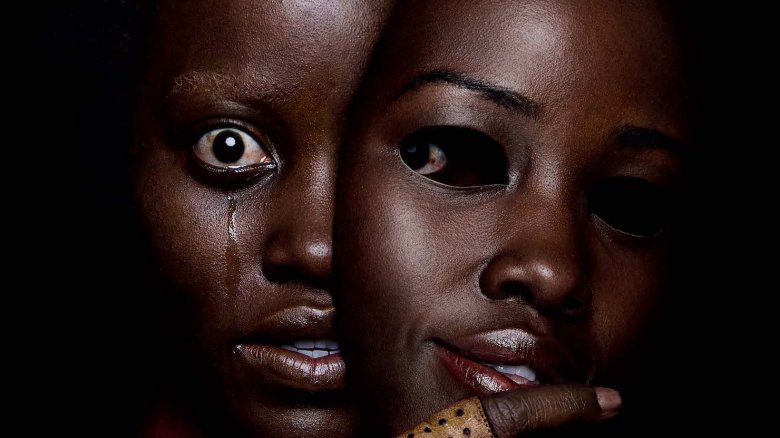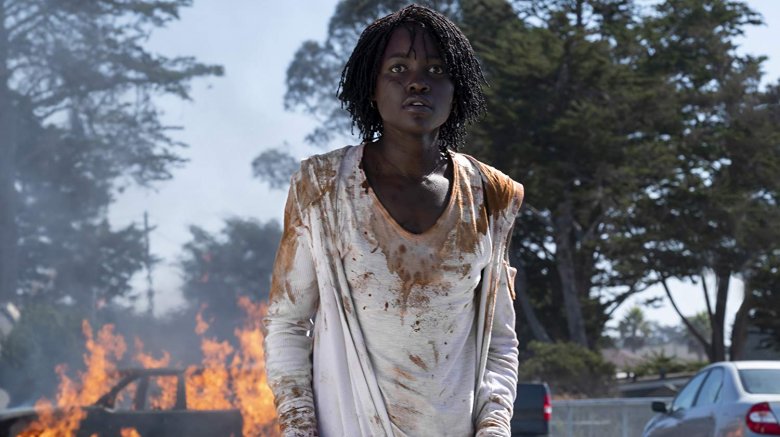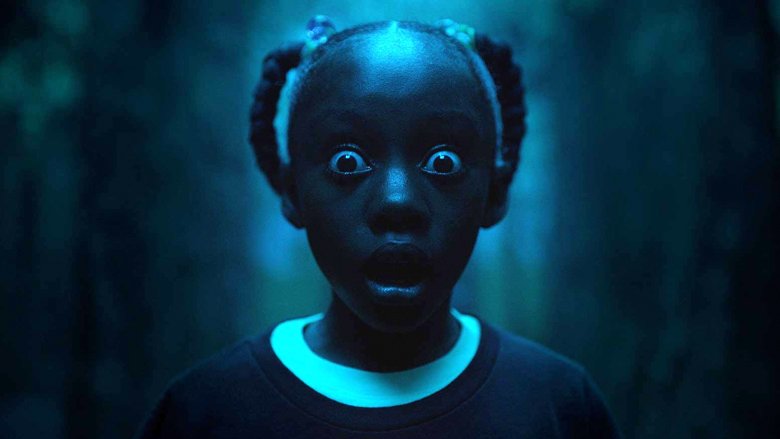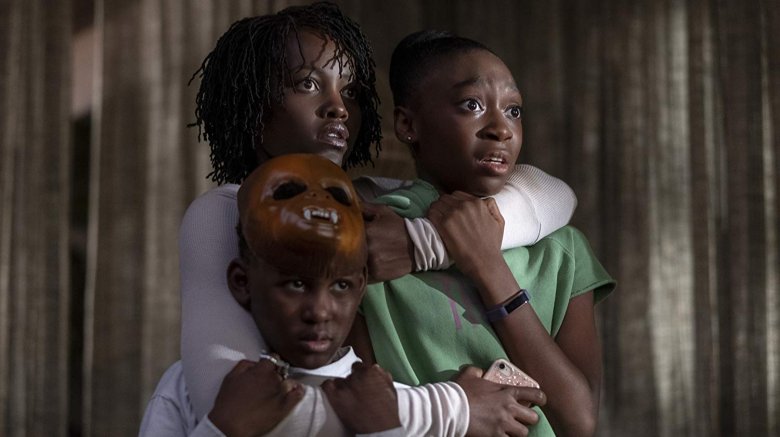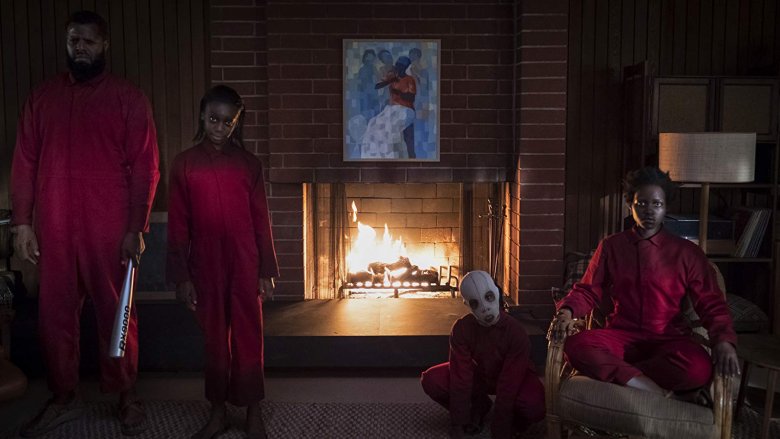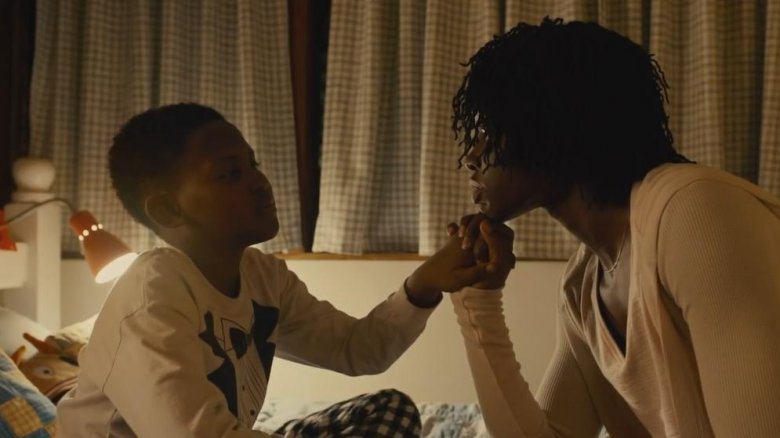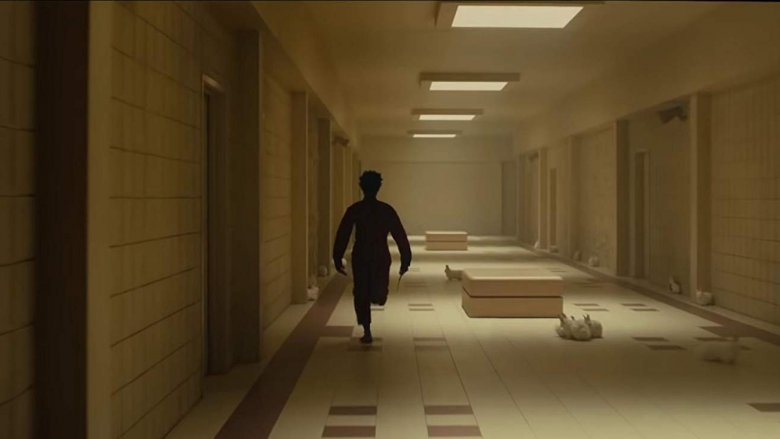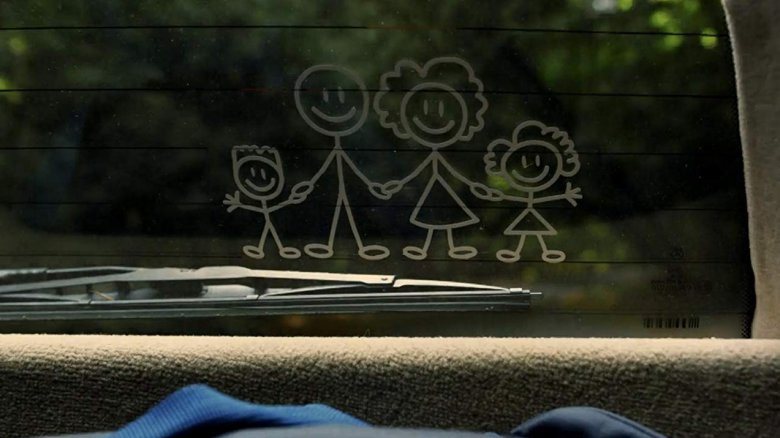The Ending Of Us Explained
Us, the second movie from writer, director, and producer Jordan Peele, is an ambitious follow-up to 2017's Get Out, the stirring, well-received debut that put him on the map as a horror filmmaker to be reckoned with. Get Out had a lot to say, but Us is arguably twice as big, twice as bold, and twice as ambitious as its predecessor, ramping up both the blood-and-guts horror content and the social commentary that helped win its predecessor an Oscar. If the dozens of A+ reviews for his sophomore effort are anything to go by, it just might be his masterpiece. But if you caught the movie and didn't catch what Peele was going for, then it might also be a pretty frustrating watch.
Three months before its release, the movie announced its impending arrival with a remarkably enticing trailer, but like all good trailers, it only teased us with the real story — so when the twists in Us start happening, they hit hard, and leave a real impression. There's a lot more going on underneath the surface of this movie than the promos show you — and we mean that literally. What exactly is this new nightmare of Peele's really about? Let's break down the many meanings of the complex end of Us.
The big reveal
Us sets up the stakes pretty early on, establishing a premise of sinister, slasher-movie doppelgängers — doubles of people with unknown but apparently murderous motives. The movie supposedly focuses on one nice, picture-perfect American family, the Wilsons, being attacked in a home invasion by brutal copies of themselves. But the scale of the movie doesn't really kick in until the third act, when it's revealed that it's not just the Wilsons having this strange experience of fighting their darker halves — it's the entire United States of America, with an unfathomably huge army of doubles being led by a woman named Red, the shadow version of Lupita Nyong'o's Adelaide.
That's the first twist the movie throws at you. But the second big twist, which it teases out slowly with carefully-written dialogue and a few scenes that are at first glance kind of inexplicable, is that the Addie the audience has been following the whole movie isn't the original Adelaide, born above ground like normal — it's her double, who switched places with her at a young age during the movie's opening flashback scene. Our heroine is one of them, and Red, the woman that's leading the doubles like a charismatic cult leader, is the original Addie that she replaced. It's the sort of game-changing narrative turn that completely changes the meaning of the movie, making you leave the theater wondering who exactly you should have been rooting for.
Post-traumatic
Throughout Us, Addie is haunted by an experience from her youth, in which she wandered into a Santa Cruz boardwalk funhouse and saw a sinister vision of herself. But the movie leaves out crucial information of what happened during that encounter, apparently reflecting the fact that Addie herself has suppressed what really happened. In her recollections, she wandered into the hokey Shaman's Vision Quest, found herself in the darkness, and then returned to her panicking parents after almost an hour had passed. But as the final frames of the movie reveal, a whole hell of a lot of consequential stuff happened during that hour — like the fact that the original Addie never came back.
In the movie's final moments, Addie realizes — or perhaps just finally admits to herself — that she is the double from the underground, who strangled the original Addie and took her place in the world, leaving the original Addie shackled to a bunk bed below to begin a new life as Red. One big clue that this is what happened is that Red is the only one of the doubles that can talk — everyone else only emits inhuman grunts and moans, with Red speaking in a raspy, damaged voice. Turns out, this comes from the damage her double did to her throat when she strangled her. When the double entered the real world, she still didn't know how to speak, leaving her parents baffled at their daughter's sudden, apparently trauma-induced muteness.
The itsy bitsy spider
All throughout the movie's first act, Addie sports a serious sense of dread, but the twist changes our perception of what that dread is all about. While there's a certain level of ambiguity going on, it seems like the adult Addie truly does not know, at the beginning of the movie, where she really came from. But she knows something is wrong, and that a reckoning is coming. One telling moment is during her confessional talk with her husband Gabe, when she tells him "I don't feel like myself," to which he replies, "I think you look like yourself." He's more right than he knows.
While the obvious animal mascot of Us would seem to be all of the bunnies running around, the real metaphorical creature seems to be the spider — specifically "The Itsy Bitsy Spider," the tune of which is a repeated motif. As Addie lays on the couch in the summer home, watching a real spider crawl out from beneath a sculpted, similar-looking fake one, we can see the wheels turning in her mind. Think about the lyrics, too — Addie is the spider who "climbed up the waterspout," getting washed out to the real world as the rain came down over Santa Cruz. Up came the sun over her new, beautiful life above ground — but down below, Red was getting jealous. She knew the world she was missing out on. So years later, she climbed up the spout again to get revenge on the woman who replaced her.
Us vs. Them
The first thing everyone who's not a big-time Bible fan did when they got home from seeing Us was probably Google the phrase "Jeremiah 11:11." Though translations differ, the sentiment is pretty clear: "It's payback time." Seriously — the International Standard Version of the passage reads, in the voice of God almighty, "I'm about to bring disaster on them from which they won't be able to escape. They'll cry out to me, but I won't listen to them." It's clear what's being set up here — an us vs. them conflict between the oppressed tethered underclass and the ignorant, privileged surface dwellers.
One big thing the Red/Adelaide twist does — aside from add a serious amount of replay value to the movie — is completely re-contextualize who you should be rooting for. Red still became quite a bad person, but realizing who she really is gives her context, making her a sympathetic villain — and vice versa.
You think you know someone...
Realizing that the person we think is Adelaide is responsible for kidnapping and replacing Red makes her a very compromised heroine. She's not a valiant mother fighting to protect her family from an otherworldly threat — she's a panicking fugazi who spent her whole life waiting for the other shoe to drop, so good at deception that she's deceived even herself.
Addie's true self is subtly revealed to the audience during some crucial moments in which she becomes somewhat monstrous while fighting for her life. One person who clearly picks up on this sense of otherworldly wrongness is her son Jason, who witnesses her growling and snarling her way through several fights. While he doesn't say anything about it, he comes to increasingly regard his mother with quizzical apprehension, even terror, realizing that the woman he thought he knew may not be who she's said she is. At the end of the movie, as Addie realizes her true nature while Jason watches, Jason pulls his quirky mask down on his head — to which Addie smiles in response, putting on a mask of her own.
Addie's true nature as a tethered person also comes into play during some of her more inexplicable actions, like getting out of the car to watch the Zora double die, or refusing to strike the double of Jason when he confronts them near a burning car. Her actions don't seem to make sense, until you understand what she's realizing: These people are her people.
Who did this?
The question of who created the tethered doesn't get answered — and that's probably for the best. It's also what Jordan Peele intended, with many of the movie's specifics being intentionally open to interpretation. Think of it less like a puzzle, and more like an ink blot.
While the viewer is first inclined to think that Addie's visit to the "Find Yourself" attraction is what triggered her doubling, the ending demonstrates that the doubles already existed underground long before she arrived. How? It's unknown. And as frustrating as it may feel for there to not be an explicit explanation, it's really not important. No answer on this Earth would be as satisfying as the mystery feels.
The obvious answer is that the doubles come from a team of government scientists, who created an unfathomably massive cloning experiment at some point in the past. But since the scale of such an operation seems truly impossible for humans to accomplish, it would be hard to take this explanation at face value. So honestly, it doesn't matter. In a logistical sense, nothing can explain how the doubles are created.
The fact is, the real villains of the movie are the people who set up this deranged experiment before abandoning its subjects, but whomever these people are, they never actually appear. In the absence of an ability to identify, confront, and fight back against their real oppressors, the characters instead fight each other. Sounds like a big fat metaphor for American society to us.
United states
Jordan Peele has described Us as being about the fear of the other, and the self-destructive tendencies that fear can cultivate. The filmmaker explained in a BBC interview, "As a nation we tend to fear the outsider. We point the finger at the mysterious invader, and that xenophobia has sort of been fueled. We also point the finger at people who aren't like us, who didn't vote like us, who live across the street from us. This movie is about the notion that maybe we are our own worst enemy."
With this framework in mind, the tethered can represent a lot of different groups. Maybe it's all the people that American society has condemned over the centuries — victims of the slave trade, mass incarceration, or a predatory economic system that leaves the poor to be impoverished as the lucky few become more privileged. They represent those who fall through the very wide holes in America's social safety nets; the vilified other; the fellow people we abandon.
The striking final shots of the movie show these people stretched across the entire continent in a human chain, hand-in-hand beneath the blue sky and the sun. For so long, they suffered, living only a shadow of the good life that their doubles so enjoyed. Not anymore, though. It took a lot of killing to get them topside, but considering the suffering they went through, it's almost hard to blame them. Remember what Red told Adelaide — they're humans, too, you know. Just like us.
